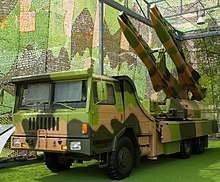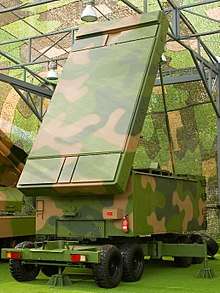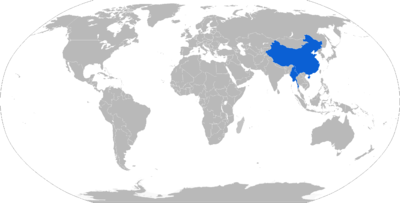KS-1 (missile)
The Kai Shan - 1 (KS-1) (凯山一号) is the first Chinese surface-to-air missile to adopt a phased array radar.


Design
The KS-1 missile was developed for the PLA as a replacement for the HQ-2(a reverse-engineered copy of the Soviet S-75 Dvina). This launcher could be mounted on a 6x6 truck to increase system mobility or be emplaced in the standard fashion.
KS-1A is the updated version, roughly the Chinese equivalent of the American MIM-23 HAWK, except it was designed to engage missiles as well as aircraft. This unique design feature means that it is the first Chinese SAM to adopt an indigenous planar passive phased array engagement radar, designated the H-200, which can simultaneously track multiple targets 100+ km away, it can guide six missiles to three targets at the same time (two missiles at each target). The new radars substantially improve the systems performance over the original KS-1.
Development
The first successful test-firing of the missile was in 1989; KS-1 development was complete in 1994. The missile was first publicized in 1998 at the Zhuhai Airshow. An improved version, the KS-1A, which greatly enhanced its minimum altitude and range, has already been developed and first appeared at the sixth Zhuhai airshow in 2006. It was rumored that this improvement also increased its ability to engage targets maneuvering at a higher g force.
History
The People's Liberation Army (PLA) preferred to wait for the improved model, the KS-1A, which has better performance, thus the KS-1 was only delivered to the Chinese armed forces in very small numbers for evaluation purposes. However, due to more advanced SAM systems being available, such as the HQ-16 and the HQ-17, it is unlikely that the PLA would ever purchase the KS-1A, the fate of both missiles is uncertain.
Both the KS-1 and the KS-1A are offered for export.
Components of the KS-1A system such as the modern planar array engagement radars could be used for upgrading legacy HQ-2 and S-75 systems, dramatically improving their performance.
Deployment
Standard deployment of a KS-1A SAM battery typically includes:
- 1 Planar Passive phased array radar (PPAR)
- 4 launchers, each with 2 missiles
- 24 missiles
- Other support equipment
Variants
- KS-1: The initial version with a SJ-202 engagement radar, which adopts a simple horn instead of a lens arrangement, the missile seeker has a traditional parabolic antenna, and can guide up to two missiles against one target. Range is in excess of 40 km. The KS-1 resembles the US SM-1 or SM-2 Standard.
- KS-1A has a range of 50 km and engagement altitude of 24 km.[1]
- KS-1C was developed by the China Aerospace Science and Industry Corporation (CASIC). Range was increased to 70 km, and engagement altitude to 27 km.[2]
- HQ-12: A derivative of the KS series that utilizes the SJ-202/212 radar.[3]
- HQ-22: The HQ-22 (export version FK-3) is China's new generation medium-range, radar-guided surface-to-air missile. It is a second-generation variant of the HQ-12, has a range of up to 170km and an effective altitude from 50 m to 27 km. It is relatively cheaper to produce than the HQ-9 and will form one of the mainstays of China's air defense system, replacing the Cold-War era HQ-2. [4][5] Command guidance/semi active radar homing guidance.[6]
Operators

Current operators
- People's Liberation Army Air Force - Commissioned as HQ-12
- Myanmar Air Force - Four battalions of KS-1A
- Royal Thai Air Force - KS-1C in service 2016.
- Serbian Armed Forces - Three batteries of FK-3
Specifications
References
- https://www.ainonline.com/aviation-news/defense/2018-01-18/thai-army-boosts-air-defense-missile-capability
- https://www.ainonline.com/aviation-news/defense/2018-01-18/thai-army-boosts-air-defense-missile-capability
- "SJ-202/212 radar for HQ-12 (in Chinese)"
- https://www.ainonline.com/aviation-news/defense/2017-08-02/china-shows-new-fighters-missiles-and-drones
- http://missiledefenseadvocacy.org/missile-threat-and-proliferation/todays-missile-threat/china-anti-access-area-denial-coming-soon/hq-12/
- https://www.armyrecognition.com/dsa_2014_official_show_daily_news_coverage_report/china_to_show_latest_generation_of_surface-to-air_missile_weapon_system_fk-3_at_dsa_2014_2004146.html
- "Archived copy". Archived from the original on 2006-10-21. Retrieved 2006-12-09.CS1 maint: archived copy as title (link)
External links
| Wikimedia Commons has media related to KS-1 missile. |